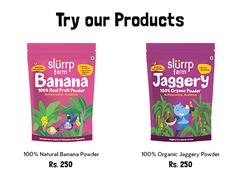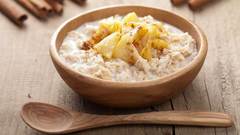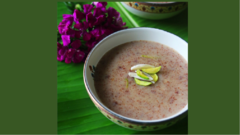The beginning of the weaning process is naturally exciting for the mother, as she hopes to give her baby the best experience. The first thoughts, quite obviously, are about identifying the best weaning foods and also the ones to steer clear of.
To begin with, it’s important to understand the characteristics of good weaning food. The nutritional quality of the food is always the foremost concern for anyone looking to decide what’s good for the baby. The ‘good food’ nutrients translate into being calorie-dense, while also providing some amount of protein, vitamins, and minerals.
Once nutrition quality passes the test, here’s what more to look for in a good weaning food. The recipe for preparation should be a relatively simple easy one and the ingredients should be easy to procure. No matter how enthusiastic a mother is, it is difficult for her to cope with tedious preparation processes on a daily basis. After all, looking after a baby is more than a full-time job, and food is just one part of the varied tasks at hand.
While providing the right nutrition, mothers also desire to serve tasty food to the baby and watch them enjoy it. At the same time, it is also every mother’s concern to avoid foods that can cause harm in any way, like inducing an allergic reaction.
Foods to avoid:
1. Uncooked or raw food
Uncooked or partially cooked eggs, undercooked or raw fish, shellfish, and honey are on the list of ‘bad foods’. The point to note here is that undercooked or raw eggs are a problem, but well-cooked eggs are very much on the ‘good food’ list. The egg yolk can be included in the diet when the weaning begins, whereas the white of the egg should be added to the diet when the baby turns 8 months of age.
2. Salt
Salt is another thing that should not be added to weaning foods. Sodium is naturally present in many of the foods that babies receive as weaning foods, so there is no requirement for added salt at this stage for the baby. There may be times when you would be cooking the food item for the baby as a part of the family meal, in which case the salt can be added at the table for older children and adults. However, it is good to remember that keeping the salt intake low for everyone is not a bad habit to inculcate. In fact, it only takes a few days for any palate to adjust to the taste of less salt in food.
|
|
3. Sugar
Sugar is not something that needs to be added to weaning foods. Sugar is a food that we as adults are trying hard to cut down on and it is a great idea to start training the taste buds from an early stage. This is why sweet biscuits and rusks are on the ‘bad food’ list for weaning. It is not uncommon for sweet biscuits and suji rusks to be dissolved in warm milk to make it of desirable texture and fed to the baby. Such foods have inherent problems. This is not because of the sugar content, but also because these biscuits contain many kinds of undesirable fats. The flour used in these foods is typical of the extremely refined kind.
The best way to sweeten a weaning food:
Fruit puree. Banana makes for a perfect sweetener in weaning foods. When the fresh banana is not available, the banana powder can be used as a substitute. Jaggery in the powdered form, in small amounts, can also be used as a sweetener for baby foods. The jaggery should be clean and hygienically prepared.
Breaking the myth:
I find that many mothers are aware of added sugar is bad for the baby but the fact that honey is also bad for babies is not so widely known. Honey contains sugar that can be just as bad for the teeth like regular sugar. Additionally, up to the age of 1 year, honey should not be part of the baby’s diet as the bacteria present in it can pose a serious danger of an infection called botulism.
Another falsehood that is perpetuated widely is about the fat in weaning foods. Many mothers mistakenly use low-fat milk for the preparation of weaning foods. The fact is that children until the age of 2 years do not require low-fat milk and low-fat dairy products.
Best foods for weaning:
Some of the preferable first foods are rice, root vegetables like sweet potato or potato, and fruits like banana. In reference to rice, it would be good to note that choosing a not so polished variety of rice would be preferable. Once you begin with any of the above-mentioned foods, the diet of the baby needs to be diversified in terms of variety and quantity. The more diversification, the better it is at providing the nutrients as well as the taste. Millets have many virtues that make it a great weaning food. Among the millets, ragi (finger millet) fits the bill very well. It contains more calcium and iron than the other cereals used for weaning.
Ragi can be sprouted and then made into a powder form. Sprouting enhances the nutritive content of ragi even more. The sprouted ragi flour can be used to make an excellent porridge.
Protein from sources like dairy (curd, milk, cottage cheese), eggs and meats should be included in the baby’s diet. These protein-rich foods go well with cereals or starchy foods like rice, ragi, potatoes, broken wheat, oats, sago, broken wheat, sweet potato, etc.
Besides keeping the nutrients in mind, the texture of the food to be introduced at the stage of weaning is also of great significance. To start with, the foods introduced should be pureed or mashed completely so that the baby does not have any difficulty in swallowing it. Begin the process with pureed foods, then move on to mashed foods progressing to minced and chopped foods at around the age of 7 to 8 months.
Whole nuts pose a danger of choking and should definitely not be a part of any weaning food. However, nut powders can be included safely. Always keep in mind the rule about introducing one new food at a time so that you can watch how the baby reacts to that particular food.
Here are some suggestions that can be part of the feeding plan:
Curd rice, khichri, porridges prepared with ragi flour blended with milk/dal are healthy and tasty options. Sweet potato mashed and mixed with dal or with milk, sago cooked in milk with added nut powder are other choices that help in diversifying the taste and well as the diet of the baby. Some other items on the list are oats, broken wheat with milk and mashed banana or cooked apple.
Please note that a variety of veggies and fruits should be added to the above-mentioned preparations to make them more wholesome. For instance, carrots, pumpkin, peas, spinach are some of the veggies that can easily to made to a consistency that is required and added to a porridge/ khichri to ramp up the vitamins and mineral content. Amongst the fruits, besides apple and banana one can include any of the seasonal fruits such as papaya, pear, cheekoo.
Caution needs to be exercised with berries and citrus fruits as it is known to cause sensitivities in some babies. Following the ‘one new food at a time’ rule will help identify any intolerances hence should be followed rigorously.
To sum up, it’s the nutrient density, diet diversity, frequency and quantities that are fed to the child during the weaning process that eventually makes a difference. Needless to say, maintaining hygiene while preparing weaning foods is of extreme importance.
The views and opinions expressed are those of the author.

Neelanjana Singh has had over 25 years of clinical experience as a dietician and diabetes educator at AIIMS, the Sitaram Bhartia Institute of Science and Research and the Diabetes Foundation. Neelanjana has also been associated with the WHO as a member of its committees and projects on nutrition and health. Her book “Our Kids Eats Everything” is a fountain of practical advice!







